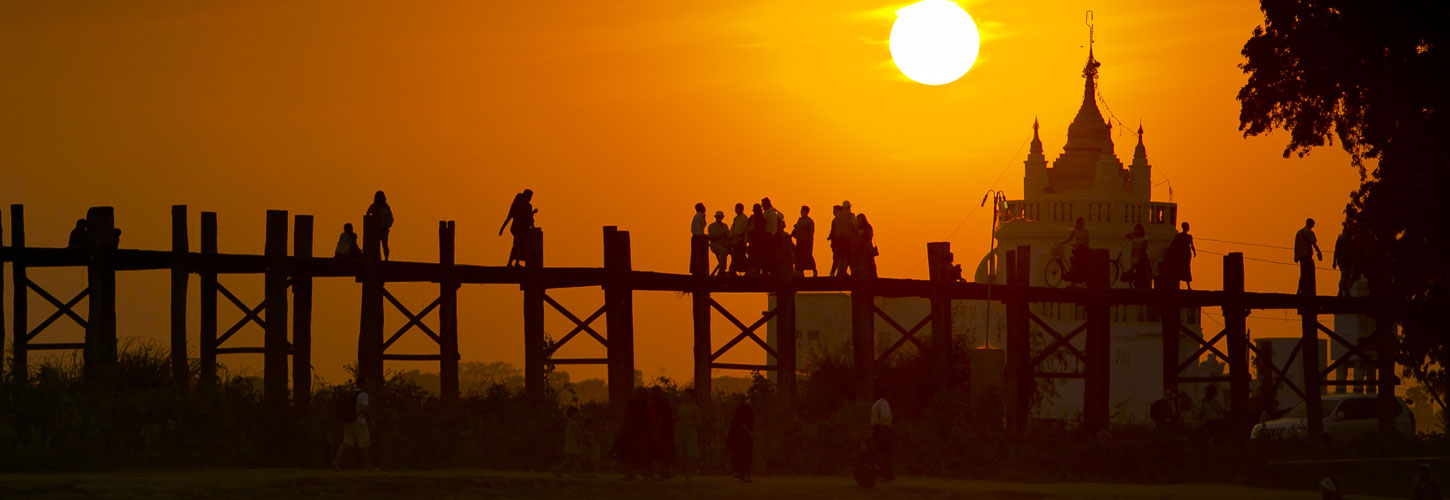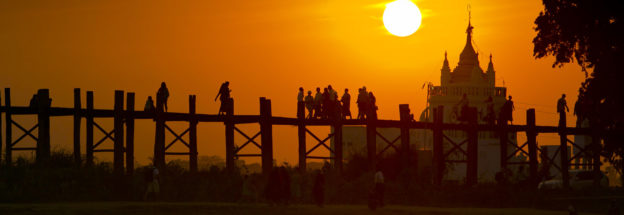YANGON & DESTINATIONS IN LOWER MYANMAR
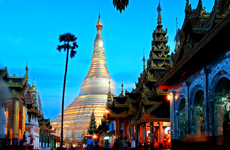

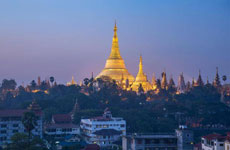
Kyaik Hti Yo
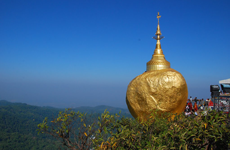
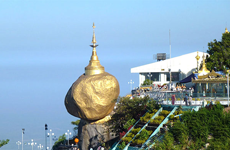
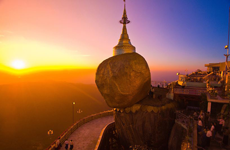
This huge bolder, also known as Golden Rock Pagoda, is covered in gold leaf and seems to balance precariously on the edge of a cliff about 120 miles ( 4 hours ) from Yangon.It is said to be balanced by a single hair from the Buddha. This is a popular pilgrimage site for Buddhists. On the way you can also enjoy the views of the Karen hills and the market stalls on the way up the hill
Bago
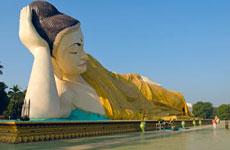
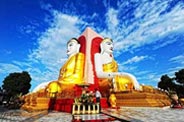
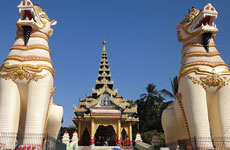
Bago, about a two hour drive north of Yangon, is on the way to Kyaik Hti Yo and has an abundance of religious sites to visit, the most famous being a 55m long reclining Buddha, the Shwethalyaung.The beautiful golden Shwemawdaw Pagoda and the old Ordination Hall are also interesting. The town was once the capital of the Mon Kingdom and a busy port. It can be visited on a day trip from Yangon if you want a whirl wind visit to the places of interest, or you can stay a night on the way to somewhere else.
Htauk Kyant – the Allies’ War Cemetery

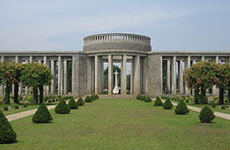

Just outside Yangon is the Htauk Kyant Allied War Cemetery was built in 1951 (consolidating a number of smaller cemeteries) to remember the sacrifice of 27000 soldiers from the British Commonwealth and its allies. These beautifully kept and peaceful gardens and impressive memorials are a place for quietly remembering and reflecting.
Thanlyin (Syriam)
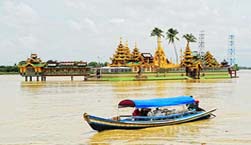
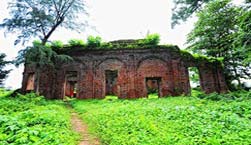
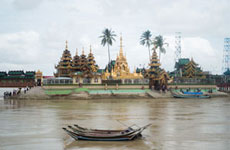
Thanlyin is just across the Bago River from Yangon. It was here that Philip De Brito, a Portuguese, established his own fiefdom. It was the main port and an important centre for trade throughout the 17th century until it was destroyed, and Yangon took over the role. Standing on a hill overlooking the Thanlyin Bridge are the remains of an old Roman Catholic Church. Attractions in the area include the Kyaik Khauk Pagoda and Yele Pagoda which is on a small island at Kyauktan.
Twante
Near Yangon is Twante which is well known for its pottery. Getting there involves a picturesque boat trip across the river to the south of Yangon and along the Twante Canal which was dug during the British colonial period as a shortcut to the delta. The rice paddy-growing countryside, a short distance away, is a contrast to the bustle of Yangon.
Pyay (Prome)
180 miles north of Yangon is Pyay (called Prome during British colonial times), known for the nearby archeological site of the ancient Pyu capital Thayekhittaya (Sri Ksetra). Sights of interest include the Shwasandaw Pagoda and Baw Baw Gyi Paya. There is also a unique Buddha image with glasses.
Mawlamyaing (Moulmein)
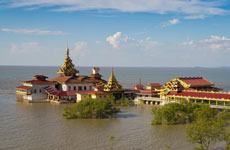

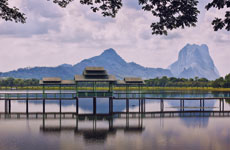
Mawlamyaing which was the capital of British Burma from 1827-1852 still has many of its old colonial buildings. The current capital of the Mon state, it is a busy coastal shipping port exporting rice and wood. During the colonial period, teak was exported from this port. George Orwell was stationed here during the 1920’s. Kipling’s Poem “ On the road to Mandalay” immortalizes the Kyaikthanlan Pagoda,( the old pagoda by the sea ) along with Mahamuni and Uzina Pagodas, which are in Mawlamyaing. The Mon cultural museum is also worth visiting. Be sure to try some of the local food as Mawlamyaing is known as the food capital of Myanmar.
MANDALAY & SURROUNDING DESTINATIONS
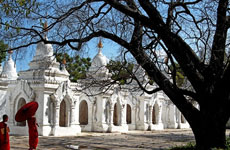

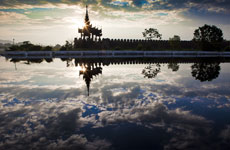
Mandalay is the last capital of the Myanmar kings, the second largest city and the heart and cultural centre of Myanmar. This is where many of the Myanmar arts and crafts are made, including weaving and tapestry, carving and metal work, and puppets. In Mandalay you can see the craftsmen at work, and buy their produce at much more reasonable prices than in Yangon. At the north of Mandalay is Mandalay Hill from which you can see panoramic views of Mandalay, the Irrawaddy River, the Sagaing Hills, the foothills of the Shan plateau and the neighbouring countryside.Mandalay is also a centre of religion with old wooden monasteries. In the south of the city there is the revered Maha Myat Muni Buddha and ancient bronze Khmer statues, both brought there by conquering Burmese kings. Mandalay makes an excellent hub for touring the surrounding regions. Not only is it one of Myanmar’s tourist spots itself, but also, most of Myanmar’s best tourist attractions are within a short distance of or a day’s drive from Mandalay.
Sagaing
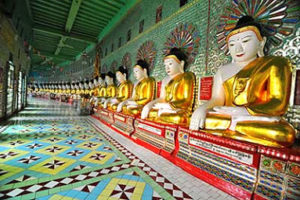
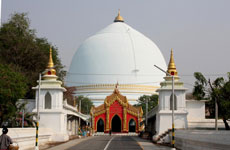
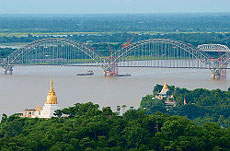
21km south-west of Mandalay on the bank of the Ayeyarwaddy River are the Sagaing Hills. These hills are picturesque covered with trees, temples and stupas.Thousands of monks and nuns live here and many Myanmar peoplecome here when stressed for a break and to enjoy the beauty and the peace of the area. There are acoustic guitar factories to visit and silversmiths in the nearby village of Ywahtaung. There are also some interesting remains of old forts along the bank of the river.
Inwa
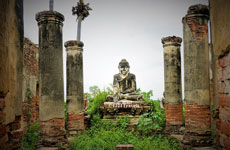
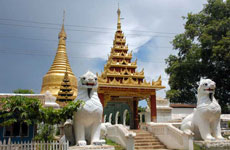
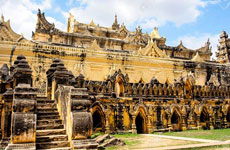
Sometimes in the raining season the only way to reach the ancient capital of Inwa (near Mandalay ) is by ferry boat as the town is completely cut off from the roads.Inwa was the capital of a Burmese kingdom for some four hundred years – longer than any other capital. Once in the town getting around the town may be by horse-drawn cart if that sort of transportation appeals to you. The carts do a tour of sights such as the 27 meter high masonry tower called Nanymyint Tower and the Bagaya monastery which is made completely of teak.
Pyin Oo Lwin (May Myo)
The cooler temperatures make Pyin Oo Lwin (named May Myo by the British ) a popular place during the hot months of March to May when many, tourists and locals alike, will visit this hill town to have a break from the heat on the plains.It also boasts the beautiful National Kandawgyi Botanical Garden, founded in 1915, where temperate plants and flowers can be walked through and enjoyed.
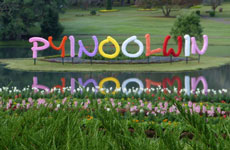
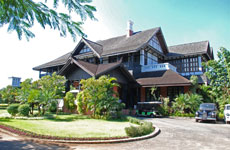
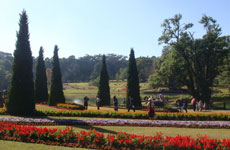
There are also waterfalls, caves and interesting old buildings from the colonial times that can all be reached using the quaint horse drawn carriages used for taxis. The town is just 42 miles from Mandalay, up an escarpment on the road to the highland towns of Hsipaw and Lashio.
Monywa
Monywa is about 140km west of Mandalay and is situated beside the Chindwin River.
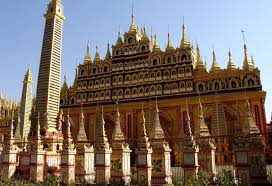
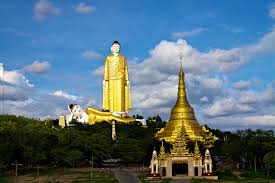
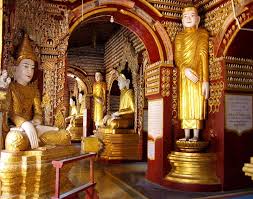
Monywa is a fascinating area to visit with its reclining Buddha peering from the Po Khaung Hills and the limestone cliff caves of Po Win Taung which are famous for their mural paintings, woodcarvings and Buddha statues. The Thahboddhay Pagoda complex with its colourful spires and a Buddha in every nook and cranny is also interesting to visit.
Amarapura


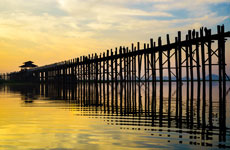
Interestingly the best known for its silk and cotton weaving, Amarapura is located only 11km south of Mandalay. It was founded by King Bodawpaya in 1783, and was the capital for 50 years until King Mindon moved it to Mandalay. Amarapura also sits at one end of the famous U Bein Bridge which is 1.2km long and has over 800 teak posts. Also near the bridge is Mahagandhayon Monastery which is known for its monastic study. Several thousand young monks live and study there.
Mingun
Mingun is located about 11km north of Mandalay on the other side of the Ayeyarwady River. It is easiest to get there by boat. By road is also possible, but it requires a significant detour south to cross the river.
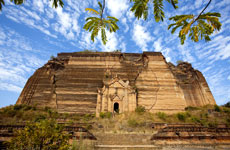
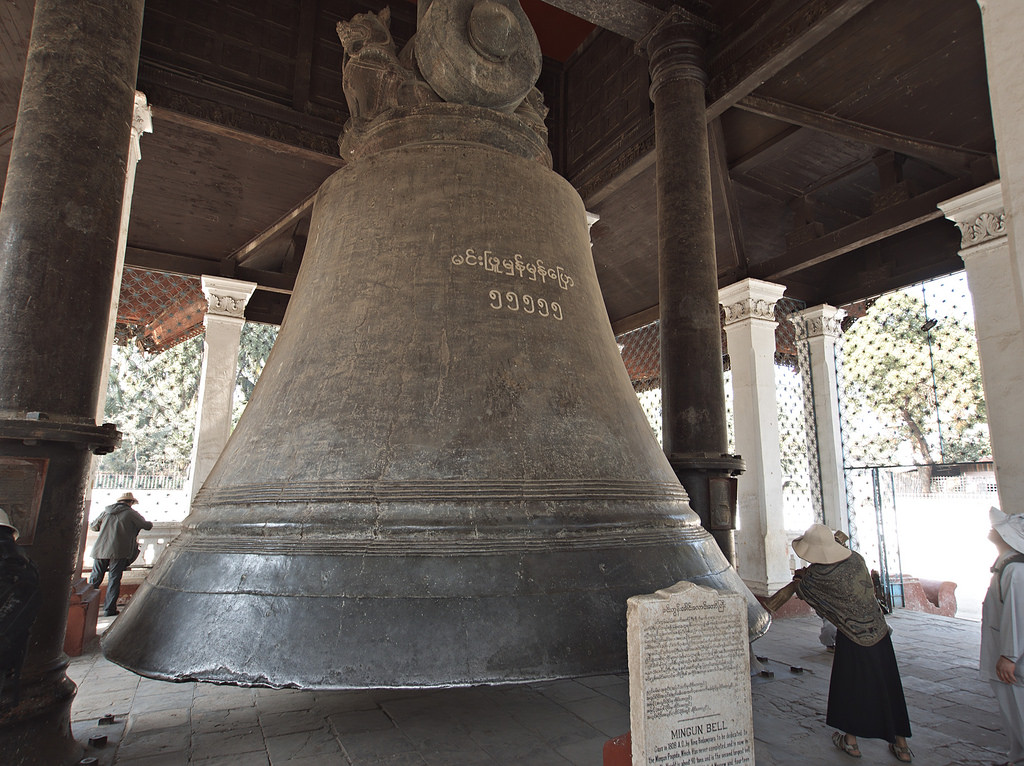
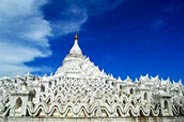
It is best known for its 90 ton bell, said to be the biggest uncracked bell in use. Also there is the ruin of Mingun Pagoda which would have been Myanmar’s biggest if it had ever been completed.
Mogok
For centuries Mogok has been famous for its gemstones, particularly rubies and sapphires. Advance permission is required to visit here, so please let us know when you are making your reservation.
BAGAN & NEARBY DESTINATIONS
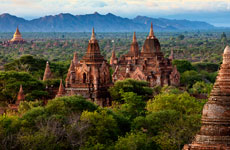
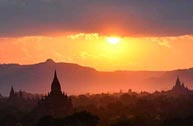
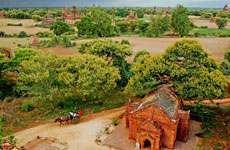
Bagan is the one place in Myanmar that you cannot afford not to visit.
A plain strewn with magnificent 10th century temples with some of the most stunning views and sunsets in Asia if not the world.
The golden age for Bagan started in 1057 and ran until it was overrun by the Mongols and Kublai Khan in 1287.
All that remains now is a 40 square km area full of old, fascinating temple and pagoda ruins. The atmosphere is tranquil and the sunsets and sunrises over the hundreds of white, golden and red buildings are beautiful.
Take a rental bike and explore the ruins. Aside from the ruins there are also lacquerware workshops to visit and watch the craftsmen at work.
Mount Popa
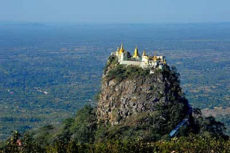
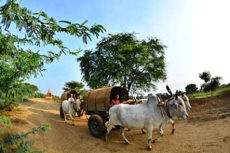
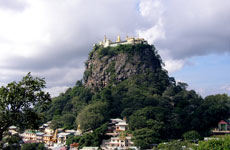
About 50 km from Bagan at the west end of the hills behind Bagan is Mount Popa. On the way you can see bits of petrified forest along the road and on the climb up to the top there are stunning views of the surrounding area.
On top of the rocky crag, possibly the core of an extinct volcano, are monasteries, stupas and shrines all reached by lovely covered walkways.
In the village of Salay about 36km south of Bagan is the Yougson Kyaung wooden monastery. Along two of the outside walls are carvings depicting 19th century court life and many scenes from the Jataka tales.Inside is a small museum containing more wood carvings from the Bagan era and from the 18th and 19th centuries. Salay has many working monasteries and an interesting mix of British colonial and Bagan era architecture.
Pokokku
Tobacco, palm sugar, thanaka logs, longyis (sarongs), and blankets are all produced in Pakokku about 27 km north of Pagan making this village an interesting place to explore.One of Myanmar’s oldest wooden monasteries can also be found in the nearby town of Pakhangyi.
INLE LAKE & SOUTHERN SHAN STATES
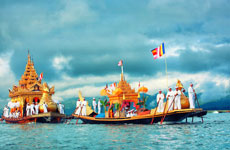
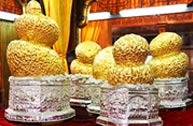
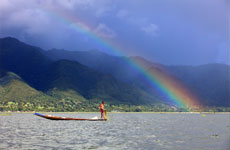
Inle Lake is a beautiful large freshwater lake on the Shan plateau reachable by air from Yangon. It is famous for its boatman who row their boats with one leg so that their hands are free. Inle Lake also has a fascinating floating market, where the Intha people sell the produce grown in their floating gardens. Even though it is cooler than the plains, it is best not to visit in the hot season as the lake can shrink dramatically in size.
Kalaw
Kalaw sits on the western edge of the Shan Plateau at an altitude of 1320 m giving it a more temperate climate which contributed to it being a popular place during the British days. The mountains surrounding Kalaw are good for walking and trekking with anything from easy half day walks to more strenuous four to five day walks. Visits can also be made to neighboring hill tribe villages that still operate the same as they did centuries ago.
Pindaya
The Pindaya cave and the Padah Lin caves near Pindya are very interesting. In the Pindaya limestone caves there are thousands of Buddhas, some centuries old, made of teak, alabaster, marble, lacquer, brick, stone and bronze. In the Pasah Lin caves is a cave whose walls are decorated with very old paintings similar to those found in caves in Europe. The beautiful Boutaloke Lake near Pindaya and the handmade paper umbrella workshops are also well worth a visit.
Kyaing Tong (Kengtung)
Kyaing Tong is actually in the eastern part of the Shan State in the Golden Triangle Region. Being surrounded by Wa, Shan, Akha, and Lahu villages means that Kyaing Tong is a good jumping off point for visiting local villages.There is a regular market attended by all the different people of the region and a twice weekly water buffalo market that are both interesting to explore. There are also many pagodas in the town that can be visited. Wat Jong Khan with its gem encrusted stupa is just to the north of the township.
MRAUK U & THE RAKHINE BEACHES
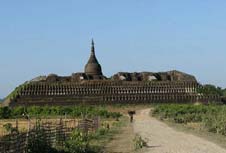
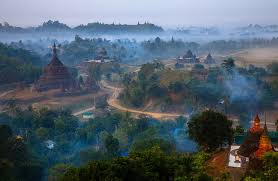
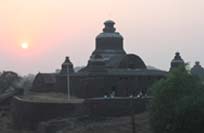
Mrauk U,another of Myanmar’s premier archeological sites is reached by boat from Sittwe. Once the capital of a powerful Rakhine Kingdom,the ruins of the old palace and the remains of the city walls are interesting places to visit.
There is also the massive Shit-thaung Pagoda which was built by King Minbin in 1535. Inside the shrine the walls are engraved with over 1000 Buddhist figures.
Sittwe(Akyab)
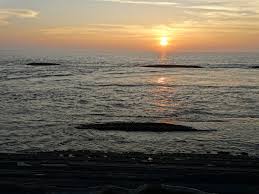
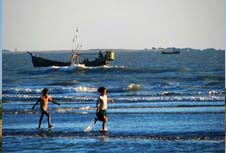
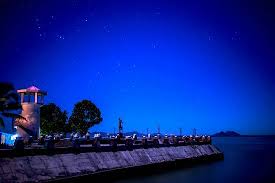
Sittwe (also known as Akyab), is the capital of Rakhine State. It is a port town and is situated in the northern end of the state at the mouth of the Kaladan River.
Sittwe is the gateway to the archaeological site of Mrauk U, however, Sittwe itself also has a number of interesting old pagodas and monasteries. During the British colonial era, it was an important port for goods coming from India.
Ngapali
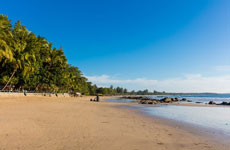
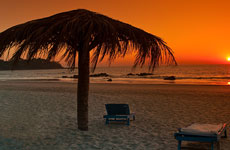
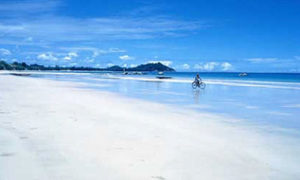
Ngapali is Myanmar’s most popular beach with its three mile long, palm tree lined, white sandy beach overlooking the Bay of Bengal. The easiest way to get there is by plane to the airport at nearby Thandwe.The local fishing industry still operates at the beach. You can see the boats out on the water at night and watch the fishermen about their work during the day. There are also several nearby villages that can be reached and explored by bike or foot.
NORTHERN SHAN STATE & KACHIN STATE
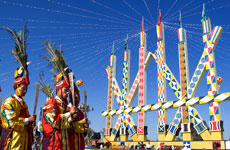
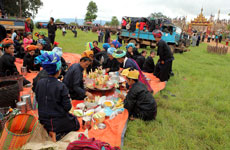
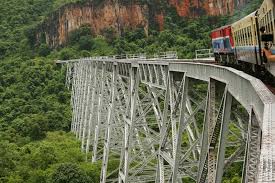
Hsipaw,Lashio, Putao and Myitkyina are places of interest in this stunning highland region.
hsipaw
Hsipaw is a quiet relaxing town in Shan State. At the north end is a Shan palace, built in European style in 1924, and still used as a residence.In February or March (depending on the Myanmar calender) one of the most significant Shan festivals at the Bo-Gyo Pagoda takes place near Hsipaw.
Lashio
Lashio is the capital of Shan State, and is located on the Shan Plateau at the start of the infamous Burma Road to the Chinese border. Lashio is the main centre of trade for northern Shan State. A mix of ethnic groups makes for a colourful market. After a day’s travel, it is good to relax in the hot springs here.
Myitkyina
Myitkyina is the capital of Kachin State, and is a good place from which to explore the neighbouring area.The confluence of the Irrawaddy River is nearby and the annual Manaw festival meeting of the Kachin tribes is a must-see if you visit here.
Putao(Fort Hertz)
Putao is a small picturesque town in the extreme north of Myanmar. It is the starting point for treks into the northern snow-capped mountains.

